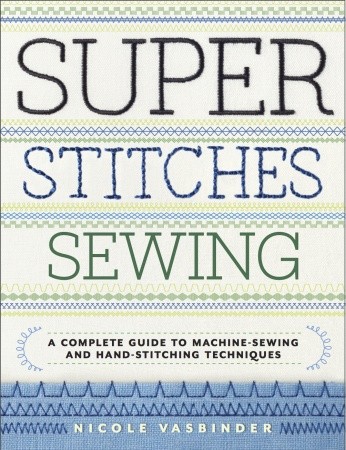(Crafting) book review: Super Stitches Sewing, by Nicole Vasbinder
Normally I do book reviews on Tuesdays. But you know what? I’m breaking the mold this week (and might continue to break it in a streak of rebelliousness against my own rules). Enjoy this midweek book review!
I am a glutton for crafting books. When Al and I were living in London and moving from corporate apartment to hotel to corporate apartment every few weeks, my loads of books came to be such a burden that we had to rent a storage space in the city so we wouldn’t have to keep lugging them around. And I felt lost without my knitting and sewing books. There’s something nice about having a reference library full of resources for those times when you get stuck on something, need inspiration, or just want to indulge in some wishful thinking. Some of the crafting books in my library fall more on the inspirational side of the spectrum (for example, Best in Show: 25 More Dogs to Knit, by Sally Muir and Joanna Osborne, is pure knitting eye candy), but when I was first (re)teaching myself to knit last year, I tore through Jennifer E. Seiffert’s Fearless Knitting Workbook, and when I got into sewing, Diana Rupp’s Sew Everything Workshop was similarly helpful. Having practical, easy-to-follow guides on hand, especially when one is still learning a craft, is essential.

I was happy to discover that Nicole Vasbinder’s Super Stitches Sewing is both practical and easy-to-use. Its premise is very straightforward: it demonstrates, in clear drawings and simple text, 50 common machine stitches and 18 hand stitches. The book is meant to be used as a reference guide: if you come across a stitch on your sewing machine that you want to know how to use, pop open the book and look it up. Or, if you’ve always wondered how to do a darning stitch, for example, but aren’t sure what it entails, you can look that up, too.
Hand stitching still scares me and I avoid it at all costs, so I decided to face my fears and test out a few of the hand stitches in the book. I sat down with a piece of scrap fabric and some thread and attempted one of my old nemeses: the backstitch. And — I think I get the backstitch now! For those of you who sew, you may be thinking, “What kind of idiot doesn’t ‘get’ the backstitch?” Um, this kind of idiot. Something about it always confounded me, but the diagram and instructions in the book helped me to see that it’s actually really easy. Oh. So, guess I can backstitch now.

I’m glad to have this book to my shelf because I think it’ll come in handy as I attempt more sewing projects over the coming months. I bought an adorable stuffed animal kit online and have been putting it off because it involves so much hand-stitching, but I think I might be able to muddle my way through it with this book by my side.
The only complaint I have about the book is that it’s not a workbook. It doesn’t claim to be, of course, but as someone who learns by doing, I would have enjoyed a couple of simple exercises that combined some of the stitches to actually make something. But this is a slim little volume with no fat or fluff; it lays out the stitches, and that’s it. Recommended as a reference guide for beginning or intermediate sewists, or for advanced sewists who aren’t sure what the heck the Walls of Troy stitch is, but would like to learn.
I received this book for free from Blogging for Books for this review!
